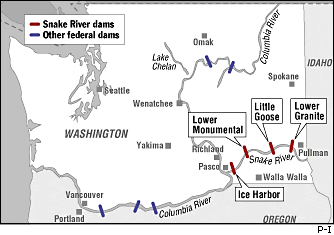forum
library
tutorial
contact

New Plan Would Put Off Dam Breaching
by StaffSeattle Post-Intelligencer, April 27, 2000
|
the film forum library tutorial contact |

|
New Plan Would Put Off Dam Breachingby StaffSeattle Post-Intelligencer, April 27, 2000 |
Fish decline would be studied 5-10 years
Federal officials next month are expected to lay out conditions that could lead to eventual disabling of the fish-killing dams of the Snake River.
But there's a big "if."
The National Marine Fisheries Service, in a long-awaited proclamation, is expected to say the controversial dams should be left in place for five to 10 years while progress of stocks of wild salmon protected under the Endangered Species Act is monitored.
If the salmon stocks are not rebounding by 2005 to 2010, the Fisheries Service could then declare that the dams must go.
 In essence, the federal government will show its hand and explain
what it thinks ought to be done -- but will not commit to a definite plan
of action. A final decision would be put off until after November's
presidential election.
In essence, the federal government will show its hand and explain
what it thinks ought to be done -- but will not commit to a definite plan
of action. A final decision would be put off until after November's
presidential election.
The Fisheries Service's "biological opinion" will be accompanied by other documents outlining what must be done to help the salmon in the so-called "four Hs" -- hydropower, or dams; habitat, which refers among other elements to how much water is left in streams; hatcheries, where fish that scientists say compete with the threatened wild stocks are produced; and harvest, or fishing.
"We will construct an opinion which we hope will lay out measurable performance standards by which we can measure progress across the H's in improving survivals," said Will Stelle, regional director of the fisheries service.
"If we are not able to make substantial progress in the other H's, then it will leave the region with little choice but to look at dams," he said.
The plan would invite the region's government leaders, businesses and residents to work to avoid dam removal by taking steps such as leaving buffers of natural vegetation along streams, covering irrigation intakes, spilling more water over dams, increasing stream flows and improving water quality.
Brian Gorman, a fisheries service spokesman, cautioned that the fisheries service must produce its so-called "All H" paper in conjunction with eight other federal agencies, including the U.S. Army Corps of Engineers.
Last year that agency had been prepared to recommend that the dams stay in place.
"This thing is still evolving," Gorman said. "This whole process has been an extremely dynamic one and the debate within the federal family has been a genuine one."
Although next month's announcement is only a recommendation, it would represent progress. Just last week the Fisheries Service was saying no recommendation would be made.
Breaching the dams, scientists say, would aid the salmon because it would help transform the Snake back from a series of pools to something closer to the free-flowing river conditions under which the salmon evolved.
The apparent disagreement among federal agencies is being played out against the backdrop of the presidential election.
While George W. Bush has come out firmly against breaching the dams, Al Gore has yet to commit himself on the issue.
Even if the Clinton administration were to make a definitive recommendation, the dams would likely remain standing for years to come.
For one thing, Congress would have to come up with money for the complicated project. Northwest representatives in Congress have vowed to fight dam breaching, because the dams allow barge traffic on the river to deliver bulk goods to market for far less than could be achieved by rail or trucks.
And even if Congress were to approve the breaching, the Corps of Engineers, which built the dams and runs them, would have to draw up plans for the breaching.
Environmentalists are likely to sue, claiming that the Fisheries Service has not met its obligations under law.
Glen Spain, northwest regional director for the Pacific Coast Federation of Fishermen's Associations, said he has suspected that the service might try to avoid a decision on dam breaching in the short term. "But we're not going to let them."
Dam defenders also want to see the Snake dams issue settled quickly and finally -- not tied to the regional issue of salmon.
Removal "has to stand or fall on its own merits," said Bruce Lovelin, executive director of the Columbia River Alliance, a coalition of dam-dependent businesses.
But Stelle said the four dams should be viewed in the context of overall salmon recovery.
"I very much view this as a decision on a comprehensive strategy for rebuilding salmon and steelhead stocks throughout the basin," he said.
"Must Snake river dams be part of the equation? Yes, they must, but they are not the sole consideration here."
learn more on topics covered in the film
see the video
read the script
learn the songs
discussion forum
